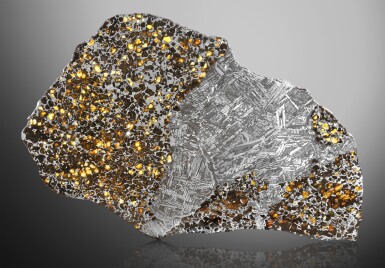
Seymchan Meteorite | Large Format Complete Slice Of A Seymchan Meteorite — Extraterrestrial Gemstones In Natural Metallic Matrix
Lot Closed
December 3, 08:53 PM GMT
Estimate
60,000 - 90,000 USD
Lot Details
Description
Large Format Complete Slice Of A Seymchan Meteorite — Extraterrestrial Gemstones In Natural Metallic Matrix
Pallasite – PMG
Magadan District, Russia (62°54’ N, 152°26’ E)
495 x 293 x 3mm (19.5 x 11.5 x 0.1 in.) and 2,384 grams (5.25 lbs.)
Now offered is one of the finest large-format slices of a transitional pallasite.
Exceedingly rare, pallasites are widely considered the most beautiful extraterrestrial substance known. Less than 0.2% of all meteorites are pallasites — and transitional pallasites (see below) represent a much smaller fraction still. Like the vast majority of pallasitic meteorites, Seymchan originated from the core-mantle boundary of an asteroid that broke apart during early solar system history. Following pinball-like impacts, a large mass was serendipitously bumped into an Earth-crossing orbit.
The crystals seen here are the result of small chunks of the asteroid’s stony mantle becoming suspended in the molten metal of an asteroid’s iron-nickel core which then crystallized. The silicate crystals of gleaming olivine and peridot (gem-quality olivine) range in hues from emerald to amber. The prominent metallic latticework dominating the middle of the slice is referred to as a Widmanstätten pattern. It is the result of a slow cooling that provided sufficient time — millions of years — for the two metallic alloys to orient into their crystalline habit. As the only place where this can happen is the core of an asteroid, the vacuum of space (and theoretically in Earth’s own core), the appearance of this pattern is diagnostic in the identification of a meteorite. When the crystals are not homogenously scattered in the matrix and present in unique arrays, this is referred to as a transitional pallasite, which is the result of its mantle-core constituents not being thoroughly mixed. In this cut and polished slice, olivine and peridot aggregates are separated in a metallic crystalline lattice in what is among the most outstanding large-format slices of a transitional pallasite known.
PROVENANCE:
Macovich Collection of Meteorites, New York City
